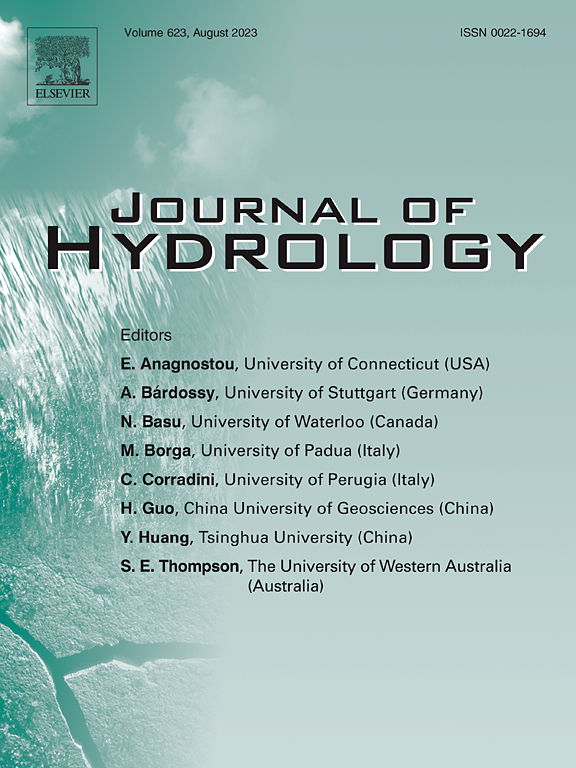珠江口潮时不对称的春季-小潮变化:优势潮汐组合及其长期演变
IF 6.3
1区 地球科学
Q1 ENGINEERING, CIVIL
引用次数: 0
摘要
潮汐持续时间不对称(TDA)是指退潮和涨潮持续时间的不平等,它对泥沙输运、河口形态和水资源管理产生重大影响。本文研究了珠江口21个站点TDA的春季小潮变化,重点分析了其时空变异、优势潮汐成分组合以及人为影响下的长期趋势。利用谱分析、Pearson相关和相对变化率方法对潮汐偏度(γN)时间序列进行分析,确定了驱动春季小潮TDA变化的主要潮汐成分组合(K1-O1-M2和M2-M4)。研究结果表明,在小潮期间,γN值一般比大潮高0.1-0.2,具有明显的半月周期性,以退潮优势增强为特征。在空间上,TDA由上游以河流为主(退潮为主)向下游以潮汐为主(洪水为主)转变,过渡区受浅水组分(M2-M4)的强烈调节。在1966-2016年期间,春季小潮TDA变率经历了实质性的长期变化(高达0.003/年),这与大坝建设、采砂和填海等重大人类干预措施明显相关,改变了潮汐组成振幅和相位。这些干预措施主要放大了小潮期间的非线性相互作用,水闸建设和填海减少了春季小潮TDA差异,而水库调节和采砂则增加了这种差异。这些发现强调了河流-潮汐相互作用和人类影响在潮汐不对称形成中的重要性,为可持续河口管理提供了重要见解。本文章由计算机程序翻译,如有差异,请以英文原文为准。
Spring-neap variations in tidal duration asymmetry in the Pearl River Estuary: Dominant tidal combinations and long-term evolution
Tidal duration asymmetry (TDA), defined as the inequality in ebb and flood tide durations, significantly impacts sediment transport, estuarine morphology, and water resource management. This study investigates spring-neap variations in TDA at 21 stations within the Pearl River Estuary, focusing on their spatiotemporal variability, dominant tidal constituent combinations, and long-term trends under anthropogenic influences. Using spectral analysis, Pearson correlation, and relative change rate methods to tidal skewness (γN) time series, we identify dominant tidal constituent combinations (K1-O1-M2 and M2-M4) driving spring-neap TDA variations. Our findings demonstrate a pronounced semi-monthly periodicity, characterized by enhanced ebb dominance during neap tides, with γN values generally 0.1–0.2 higher than during spring tides. Spatially, TDA shifts from river-dominated upstream zones (ebb dominance) to tide-dominated downstream areas (flood dominance), with the transition regions strongly modulated by shallow-water constituents (M2-M4). Over the 1966–2016 period, spring-neap TDA variability experienced substantial long-term changes (up to 0.003/year), clearly associated with major human interventions, such as dam construction, sand mining, and reclamation, altering tidal constituent amplitudes and phases.. These interventions primarily amplified non-linear interactions during neap tides, with sluice construction and reclamation reducing spring-neap TDA differences while reservoir regulation and sand mining increasing this difference. These findings underscore the importance of fluvial-tidal interactions and human impacts in shaping tidal asymmetry, providing critical insights for sustainable estuarine management.
求助全文
通过发布文献求助,成功后即可免费获取论文全文。
去求助
来源期刊

Journal of Hydrology
地学-地球科学综合
CiteScore
11.00
自引率
12.50%
发文量
1309
审稿时长
7.5 months
期刊介绍:
The Journal of Hydrology publishes original research papers and comprehensive reviews in all the subfields of the hydrological sciences including water based management and policy issues that impact on economics and society. These comprise, but are not limited to the physical, chemical, biogeochemical, stochastic and systems aspects of surface and groundwater hydrology, hydrometeorology and hydrogeology. Relevant topics incorporating the insights and methodologies of disciplines such as climatology, water resource systems, hydraulics, agrohydrology, geomorphology, soil science, instrumentation and remote sensing, civil and environmental engineering are included. Social science perspectives on hydrological problems such as resource and ecological economics, environmental sociology, psychology and behavioural science, management and policy analysis are also invited. Multi-and interdisciplinary analyses of hydrological problems are within scope. The science published in the Journal of Hydrology is relevant to catchment scales rather than exclusively to a local scale or site.
 求助内容:
求助内容: 应助结果提醒方式:
应助结果提醒方式:


